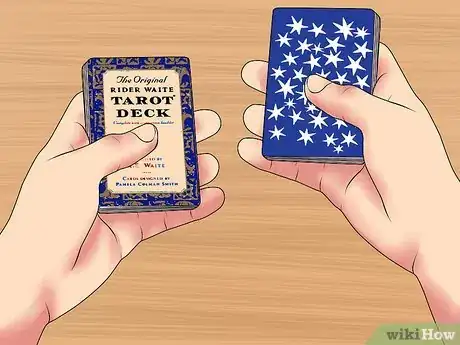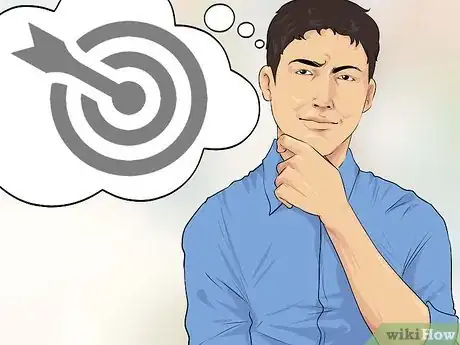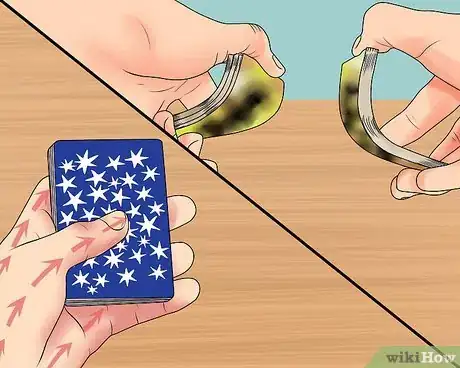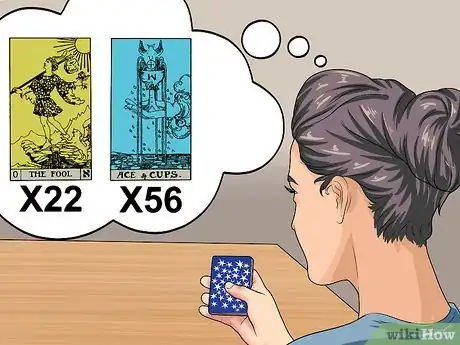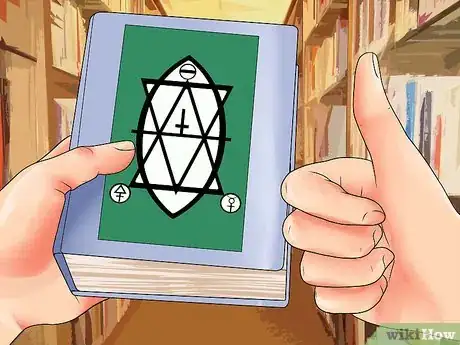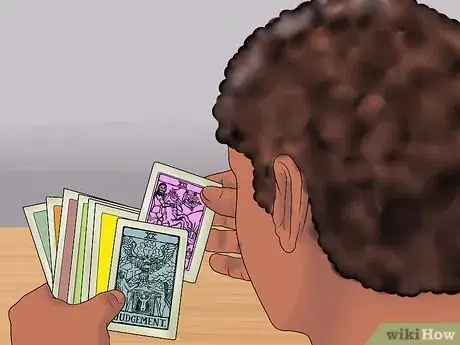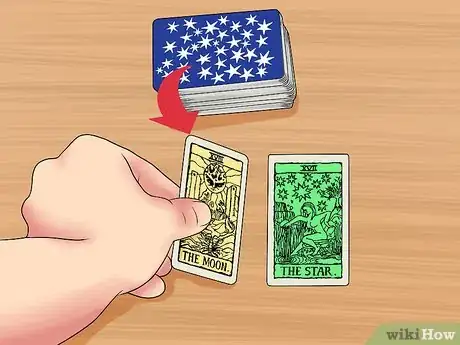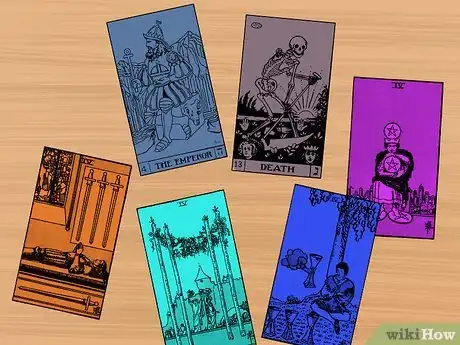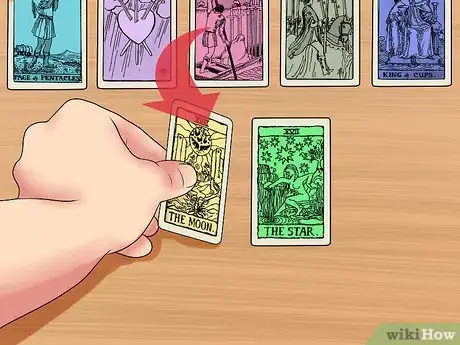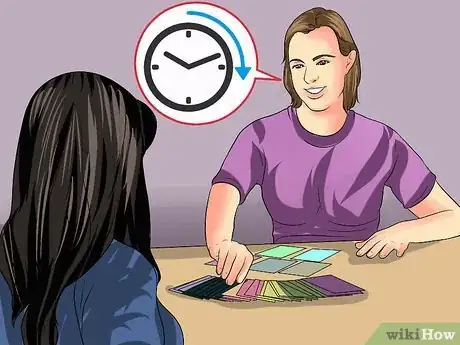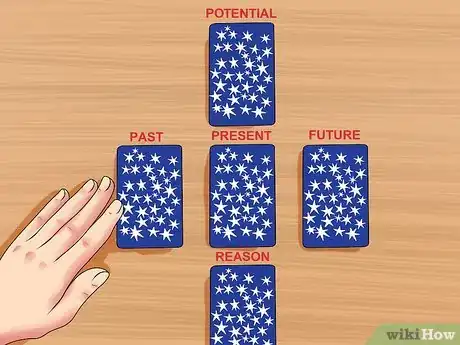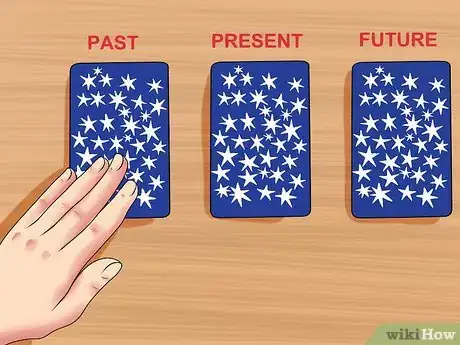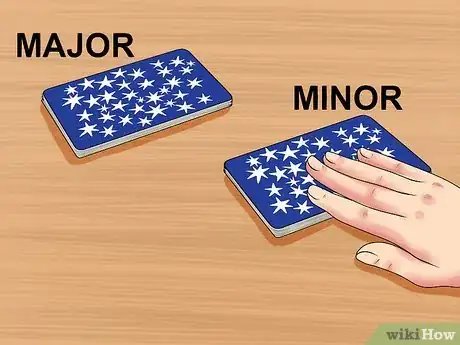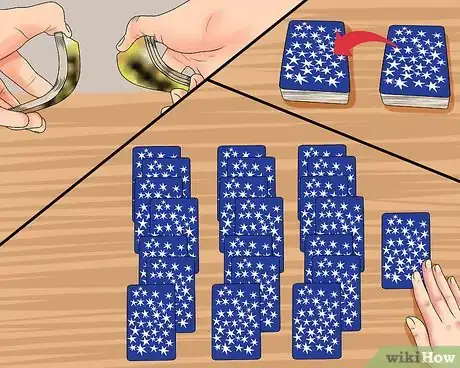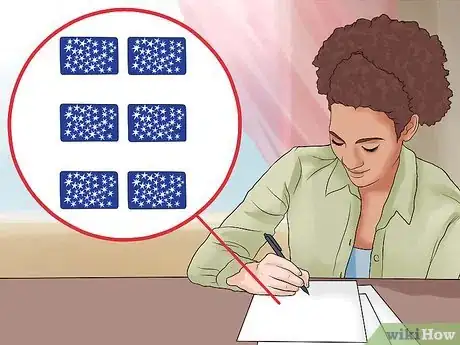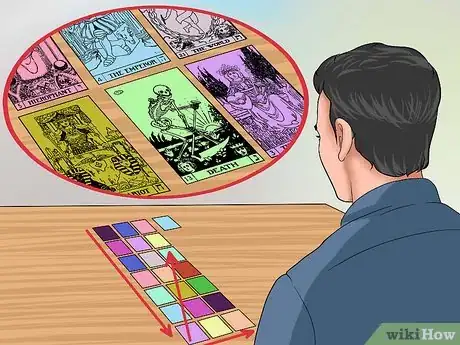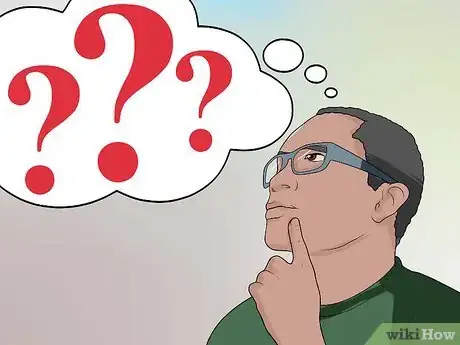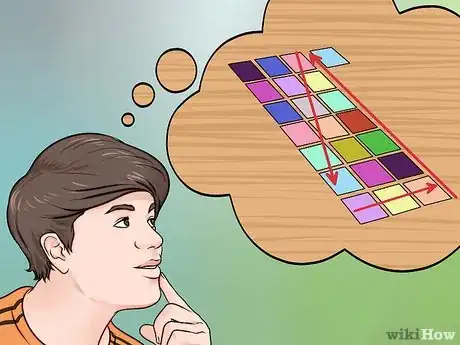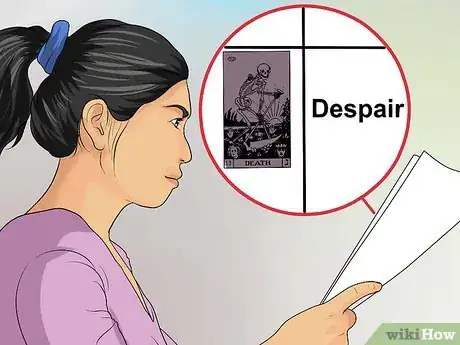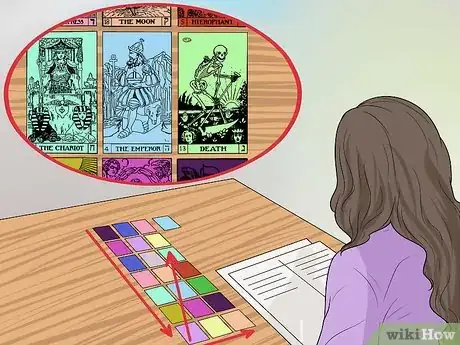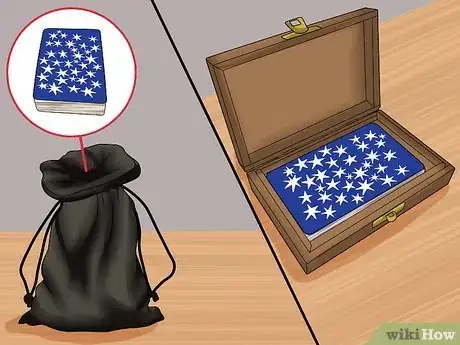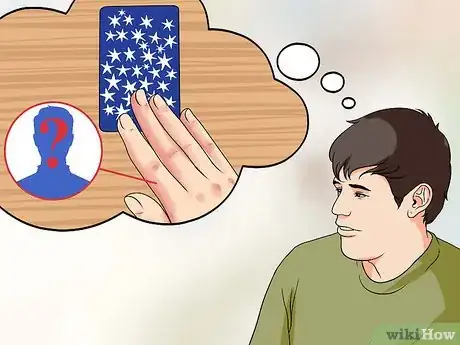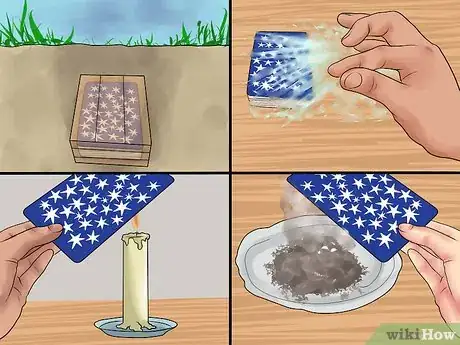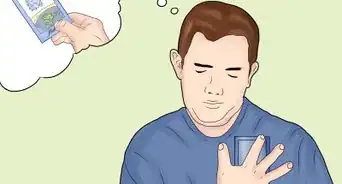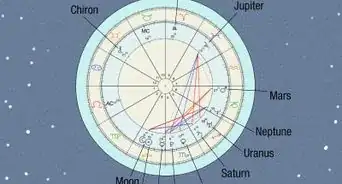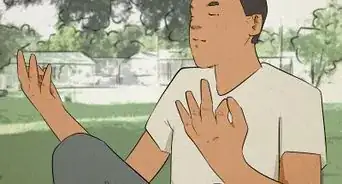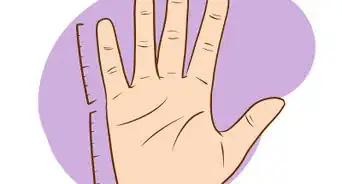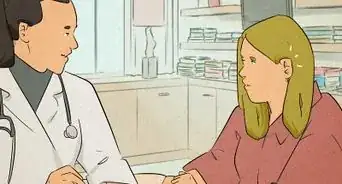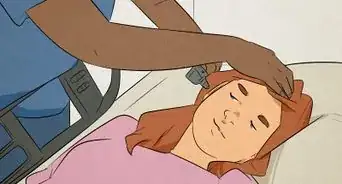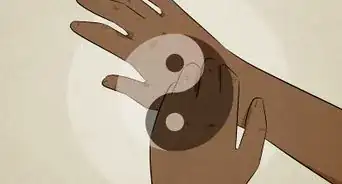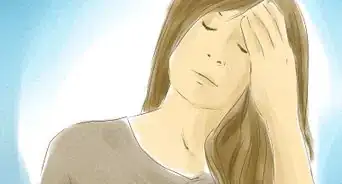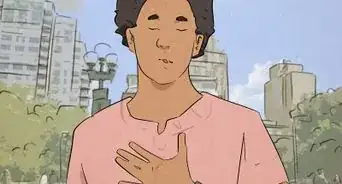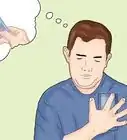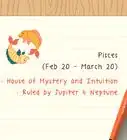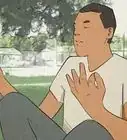This article was co-authored by Susan Levitt. Susan Levitt is a professional tarot card reader, astrologer, and feng shui consultant based in San Francisco, California since 1986. Susan is the author of five books that are published in several languages including Introduction To Tarot and Taoist Astrology. She posts tarot reading updates on Facebook, on Twitter @tarot_tweet, and her lunar blog. Her work has been featured on CNN and she was voted “Best Astrologer” by SF Weekly in San Francisco.
wikiHow marks an article as reader-approved once it receives enough positive feedback. This article received 22 testimonials and 95% of readers who voted found it helpful, earning it our reader-approved status.
This article has been viewed 1,030,937 times.
Learning to read Tarot cards takes a combination of knowledge and intuition that anyone can develop. Follow the steps below to hone your abilities as a Tarot card reader to offer insight and guidance to those who seek it or to aid in your own personal growth.
Steps
Get Familiar with The Tarot
-
1Choose a deck of cards. Different tarot decks use different symbology. One of the most widely used and most widely taught is the Rider-Waite Tarot or one of its clones--the Morgan-Greer Tarot, for example. Still, it's important that a tarot deck speak to you, so look through different ones and read reviews to learn what people like and dislike about them.
- Classic and popular decks are always in circulation, but new tarot decks are published each year so there is an ever-changing inventory to look through.
- The top five tarot decks of all time are: Deviant Moon Tarot, Rider-Waite Tarot, Aleister Crowley Thoth Tarot, DruidCraft Tarot and Shadowscapes Tarot.[1]
-
2Develop a mission statement. Defining exactly what you hope to accomplish in your relationship with the Tarot can help you on your journey as a reader. When you know your desired end result, you'll be better able to look objectively at where you are now and what steps you must take to reach your "destination." Ask yourself your intention for your Tarot deck or how you plan to use it to serve others. Mission statements may reflect goals such as wanting to develop greater intuition, enhance creativity or connect with spiritual forces. These statements are different and personal to each individual who crafts one.Advertisement
-
3Transfer your energy to the deck. The best way to do this is to handle the cards. Shuffle them again and again. Put them in order (from Fool through the World, followed by each of the suits, from Ace through Ten, then Page, Knight, Queen and King). Handling your cards helps them to become an extension of you.
-
4Understand how the deck works. The Tarot deck is made up of 78 cards: 22 major arcana and 56 minor arcana. You must memorize and be able to identify each card as well as give two divinatory meanings for each card.
- Major arcana. The Tarot archetypes represented in the major arcana are pictures that represent life and the stages and experiences we all go through. It's meant to be the story of one's journey through life starting as The Fool (young, pure energy in spirit form) moving through events and cycles and finding completion in The World (the end of our life cycle).
- Minor arcana. Minor Cards describes the people, events, feelings and circumstances we encounter on our personal "Fool's Journey."[2]
It represents events that are within the control of the individual and indicate how you do something. The minor arcana fairly closely resembles a traditional deck of playing cards. It's made up of four suits, and each of these suits are associated with one of the elements: Wands (Fire), Cups (Water), Pentacles (Earth) and Swords (Air). There are also the Queen, King and Knight (or Jack) of each suit plus the addition of Pages or Princesses.
- Memorizing all 78 cards will take time. Try working with a partner who can quiz you using the deck as a kind of set of flash cards.
-
5Get a good book. A well-written book that will help you understand the basics of Tarot will be extremely helpful in getting you started reading tarot cards. Some take you through the process in a way that emphasizes memorization while others encourage participation. Choose a book that suits your learning style.
- Don't plan to rely too heavily on your book. It will be helpful to get you on track for learning, but you need to integrate your intuition with your book knowledge to fully develop as a Tarot card reader.
- Try this trick for incorporating your intuition into your learning. Look at each card and decide what you think it means. Don't worry about being right--just go from your gut. Then look in your book and see what it says. This will take the focus off pure memorization and the fear of being wrong and allow you to create readings that flow because of the way you've personally connected with the cards.[3]
EXPERT TIPSusan Levitt is a professional tarot card reader, astrologer, and feng shui consultant based in San Francisco, California since 1986. Susan is the author of five books that are published in several languages including Introduction To Tarot and Taoist Astrology. She posts tarot reading updates on Facebook, on Twitter @tarot_tweet, and her lunar blog. Her work has been featured on CNN and she was voted “Best Astrologer” by SF Weekly in San Francisco.Tarot Card Reader
 Susan Levitt
Susan Levitt
Tarot Card ReaderOur Expert Agrees: There are a lot of excellent books that can teach you how to read tarot cards. You can also find apps or websites that show and explain a card every day, or you can go for a personalized tarot reading and learn from watching.
Play Around with the Basics
-
1Pick a card-a-day. You can choose a card simply as a way of getting to know the deck or you may pick one to get some insight into the day ahead of you.
- To get to know the deck. Choose a card at random and gaze at it a bit. Write down your first impressions and intuitive thoughts. Write these with one particular color of ink a journal or notebook. With a second, different ink color, write down more information you find about the card from other sources (books, e-groups, friends). After a few days, review what you've written and add comments in a third color of ink.[4]
- Get a daily reading. Choose a card at random the first thing in the morning. Spend some time looking at it. Pay attention to its colors and how you react to them. Note the general atmosphere of the card and the emotions it brings out in you. Look at the figures in the card--what they're doing, whether they're seated or standing, who they remind you of and how you feel about them. Focus on the symbols and what they remind you of. Write your thoughts down in a journal--you can refer back to this as a learning tool and use it to track your progress.[5]
-
2Study card combinations. It's important for beginners to view the Tarot not as 78 separate cards but as a system of patterns and interactions. Studying card combinations can help you embrace that concept. Draw two cards from the deck and put them face up next to each other. Now, look for images, locations or events within the two-card combination. You can work with more cards or do an entire spread. The idea is to learn the cards in combinations to develop deeper understanding and greater confidence when it comes time to doing a reading.
-
3Make constellations. Tarot constellations are made up of all cards that carry the same digit (number one through nine). For example, the Tarot constellations for the number four would be the number four card from each of the suits, the Emperor (which carries the number four) and Death (which carries the number 13 but reduces to the number four (1+3=4).[6]
- Line up all the cards from a constellation in front of you and ask yourself some questions such as how you feel about each card, what attracts, repels, annoys or makes you anxious about the cards, how they're alike and how they're different and what symbols they seem to share. Repeat this exercise for each of the nine prime numbers and record your impressions in a journal.
- Understanding the energy of each of these cards will facilitate a smoother reading when multiples of the same number come up. Instead of focusing on the meaning of individual cards, you'll be able to focus on the energy they bring in as a group.[7]
-
4Play the card resolution game. Go through your deck and pull out cards that strike you as being difficult. Spend some time with them to try to get to the root of your impression. Then go through the deck again and pull out one or more cards that you feel brings resolution to those difficult cards.
- This game actually helps you develop a skill you can use in your readings. When a difficult card comes up in one of your readings and you want to help the Seeker resolve that issue, you can suggest a card that will counteract the difficult card.[8]
Do a Simple Reading
-
1Tell a story. A Tarot reading is a narrative, a story that you tell to the Seeker. It's an attempt to highlight past influences, understand present circumstances and predict the most likely future. The future you speak of will not be a fixed or definitive outcome; it's important to remember that there are no conclusive endings or absolutes.
-
2Get familiar with spreads. A "spread" simply refers to the layout of your cards. A Tarot spread is a configuration or pattern of cards. That pattern provides the framework for a tarot reading. Further, each position of the tarot cards in a spread has a specific meaning. Your reading will use the placement or position of the cards within an identified theme. For example, many spreads include positions for the past, present and future. They can also include positions for internal feelings, specific challenges, external factors and so on. There are hundreds of spreads to try, and more experienced readers can make up their own. Experiment with different spreads, trying especially to choose ones that encourage your imagination and intuition. Figuring out what works best for you is important; many readers come to rely on specific spreads that work best for them.[9]
-
3Start with a Three-Card Spread. A three-card spread is great for divining answers to uncomplicated questions, for refocusing on simplicity an for beginners who have just started reading. Assign the positions in advance, lay out your spread and use what you've learned about card meanings and combinations to tell a story.
- Some possible positions for a reading designed to understand a situation are: past/present/future, current situation/obstacle/advice, where you stand now/what you aspire to/how to get there and what will help you/what will hinder you/what is your unrealized potential.
- Some possible positions for a reading designed to understand relationships are: you/the other person/the relationship, opportunities/challenges/outcomes, what brings you together/what pulls you apart/what needs your attention and what you want from the relationship/what you want from the relationship/where the relationship is heading.
- Some possible positions for a reading designed to understand relationships are: mind/body/spirit, material state/emotional state/spiritual state, you/your current path/your potential and stop/start/continue.[10]
Do a More Complex Spread
-
1Separate your cards. To begin this 21-card spread, separate the Major Arcana from the Minor.
-
2Create the spread. Shuffle each set of cards, cut them and lay them out in rows of three across, seven down with one card to the side. This will use all of the Major Arcana but leave some Minor Arcana cards. Set these aside in a pile.
-
3Write down impressions. Make a list of the cards you've laid out. Pick a word that best describes each and write it down beside them.
-
4Look at the pictures on the cards. What do they suggest to you? Identify a narrative pattern, as though you are looking at a book of illustrations and trying to find the story. The patterns can go across, down, diagonally or first to last. The card to the side signifies the most important element of the situation.
-
5Ask questions. Ask yourself which situations in your life or in the life of the person whose cards you are reading, the cards seem to be alluding to.
-
6Consider alternatives. Look for narrative patterns that offer alternatives to the end first perceived, things that could make the situation better or worse.
-
7Review your words. Consider the words you've assigned to each of the cards. How do these apply to the stories you've identified?
-
8Put it all together. Combine your perceptions from the above steps into one reading. You might be amazed at how much more accurate the reading is than when you use the deck's guide.
- Remember that if at some point a card feels like it has a different meaning to you than what the book says, go with that meaning. Trusting your intuition is the true way to read tarot cards and something you'll begin to do naturally you become more experienced. Just let the cards speak to you.
Protect Your Deck
-
1Store your deck properly. Tarot cards can pick up negative energy that can interfere with your readings. It is recommended that you store your cards in a black-lined bag or in a wooden Tarot card box. You can add in gemstones or herbs that increase psychic abilities.
-
2Decide who can touch your cards. It's a matter of personal preference as to whether or not you'll allow the Seeker to touch your cards. Some readers encourage it--the have them shuffle the deck as a way of transferring their energy to the cards. Other readers prefer not to have anyone's energy except their own on the deck.
-
3Clear your deck. There will be times when you need to clear or cleanse your deck to rid it of negative energy. There are many ways to it, but one simple way involves calling on one of the four elements. When using this method, begin by fanning the deck; if extreme cleansing is needed, the cards can be cleared one at a time.
- Earth. Bury your protected deck in sand, salt or dirt for 24 hours. Alternatively, fan your deck on a tablecloth and sprinkle it with salt and/or sand for one to two minutes or any combination of basil, lavender, rosemary, sage or thyme.
- Water. Sprinkle your cards lightly with water, herbal tea or a plant infusion and wipe immediately or expose your deck to moonlight in a protected area for half the night.
- Fire. Taking care not to burn yourself, pass your deck quickly through a candle flame. You can also expose your deck to sunlight in a protected area for half a day.
- Air. Pass your deck five to seven times over burning incense. Or try instead taking a deep breath and breathe deeply and slowly into your deck three times.
Community Q&A
-
QuestionDoes learning to read tarot cards open your "third eye" and cause you to see ghosts?
 Community AnswerLearning tarot does not make you able to see ghosts. Tarot cards help you develop greater intuition and understanding.
Community AnswerLearning tarot does not make you able to see ghosts. Tarot cards help you develop greater intuition and understanding. -
QuestionIs there a different meaning when the cards are upside down?
 Community AnswerYes. Sometimes it is a subtle difference in interpretation and sometimes significant, depending on the card and where it falls in your spread. If look at a tarot book, it will let you know the differences between the upright and reversed cards.
Community AnswerYes. Sometimes it is a subtle difference in interpretation and sometimes significant, depending on the card and where it falls in your spread. If look at a tarot book, it will let you know the differences between the upright and reversed cards. -
QuestionWhat happens if I burn my card accidentally while clearing it?
 Community AnswerIn that situation, you have damaged your piece of card stock. If it is only very slightly damaged, there's no reason why you couldn't continue to work with it. If the edges are damaged, however, you will always know where it is in the deck when shuffling and drawing, and that is counterproductive. It is not necessary to have a flame anywhere near your cards to 'clear' them. It is YOU who may need 'clearing' rather than your cards. YOU are the one who reads the Tarot. Anything that clears your mood or your mind clears your cards for Tarot work.
Community AnswerIn that situation, you have damaged your piece of card stock. If it is only very slightly damaged, there's no reason why you couldn't continue to work with it. If the edges are damaged, however, you will always know where it is in the deck when shuffling and drawing, and that is counterproductive. It is not necessary to have a flame anywhere near your cards to 'clear' them. It is YOU who may need 'clearing' rather than your cards. YOU are the one who reads the Tarot. Anything that clears your mood or your mind clears your cards for Tarot work.
Warnings
- If you believe strongly in free will, that does not mean you cannot benefit from tarot's descriptive power. Rather than a prediction, think of a tarot reading as a road map which helps you choose where you want to go rather than steering you in a particular direction.⧼thumbs_response⧽
- Remember to take this with a grain of salt.⧼thumbs_response⧽
- Some decks can give you nasty paper cuts. Take care!⧼thumbs_response⧽
References
- ↑ http://www.aeclectic.net/tarot/cards/topten.shtml
- ↑ http://www.thewhitegoddess.co.uk/the_tarot/the_major_arcana.asp
- ↑ http://www.aeclectic.net/tarot/learn/learning_the_tarot.shtml
- ↑ http://www.aeclectic.net/tarot/learn/learning_the_tarot.shtml
- ↑ http://www.aeclectic.net/tarot/learn/learning_the_tarot.shtml
- ↑ http://www.aeclectic.net/tarot/learn/learning_the_tarot.shtml
- ↑ http://www.aeclectic.net/tarot/learn/learning_the_tarot.shtml
- ↑ http://www.aeclectic.net/tarot/learn/learning_the_tarot.shtml
- ↑ https://www.youtube.com/watch?v=kFT1uiWZixg
About This Article
To read tarot cards, start with a basic three-card spread by laying 3 cards out in front of you, face down in a horizontal line. Then, flip the card on the left to learn about your past, the middle card to learn about your present, and the card on the right to learn about your future. If you don't know what each card means yet, look up the meanings online or in a tarot card book until you memorize them. You can also use the same three-card spread to give someone else a reading. To learn how to do more complex tarot card spreads, scroll down!
